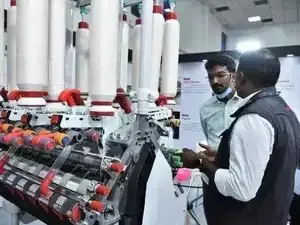
An analysis of about 40 home textile companies, which account for 40-45% of the industry revenue, by Crisil has indicated that the home textile manufacturers are bracing for a 5-10% decline in revenue apart from reduction in operating profitability, as the 50% tariffs imposed by the US came into effect on August 27, 2025. Exports of home textiles account for about three quarters of the industry’s revenue.
Three factors would soften the blow somewhat—frontloading of sales during April-August 2025; limited capacities of competing nations, such as China, Pakistan and Turkey2 with lower tariffs in the product categories supplied by India; and, likely diversification of Indian manufacturers to alternative geographies. Additionally, deleverage balance sheets will partly offset the impact on credit profiles.
Says Manish Gupta, Deputy Chief Rating Officer, Crisil Ratings, “Home textiles are discretionary products and their exports to the US grew a modest 2-3% in the first quarter of this fiscal as retailers remained cautious of demand amid inflationary concerns. But prior to the implementation of higher tariffs from August 27, exports had spiked because of some frontloading of orders. Additionally, with competing countries having limited capacity to make cotton-based home textile products, India should be able to maintain its competitive position in the US market over the near term. That should limit the overall revenue decline for the industry to 5-10% this fiscal.”
The impact is expected to be more pronounced for companies that generate more than half of their revenue from the US. To offset the lower offtake in the US, Indian manufacturers would try to increase trade with the European Union (EU) and the United Kingdom (UK). These geographies together accounted for ~13%4 of India’s home textile exports last fiscal. Domestic exporters are expected to sharpen focus on the UK, where the gates have opened after the recent free trade agreement, and the EU.
Says Gautam Shahi, Director, Crisil Ratings, “Scaling up of revenue from the alternative export destinations will take time. Meanwhile, operating profitability on exports to the US over the remainder of this fiscal may decline sharply. This will be a result of the Indian exporters absorbing part of the higher tariffs and some expected reduction in demand from the US due to inflation. The potential oversupply may also affect the profitability of exports to other destinations as well as in the domestic market. Consequently, operating profitability at the industry level could fall 200-250 bps this fiscal from last fiscal.”
Cash accruals will thus be lower this fiscal relative to last fiscal, leading to weakening credit metrics of home textiles manufacturers. The interest coverage ratio could decline to ~4.0 times this fiscal from 5.4 times last fiscal. Financial leverage, denoted by the debt-to-Ebitda ratio, is expected to weaken to 2.4-2.6 times from 1.9 times—and more sharply for manufacturers with high exposure to the US market.
Three factors would soften the blow somewhat—frontloading of sales during April-August 2025; limited capacities of competing nations, such as China, Pakistan and Turkey2 with lower tariffs in the product categories supplied by India; and, likely diversification of Indian manufacturers to alternative geographies. Additionally, deleverage balance sheets will partly offset the impact on credit profiles.
Says Manish Gupta, Deputy Chief Rating Officer, Crisil Ratings, “Home textiles are discretionary products and their exports to the US grew a modest 2-3% in the first quarter of this fiscal as retailers remained cautious of demand amid inflationary concerns. But prior to the implementation of higher tariffs from August 27, exports had spiked because of some frontloading of orders. Additionally, with competing countries having limited capacity to make cotton-based home textile products, India should be able to maintain its competitive position in the US market over the near term. That should limit the overall revenue decline for the industry to 5-10% this fiscal.”
The impact is expected to be more pronounced for companies that generate more than half of their revenue from the US. To offset the lower offtake in the US, Indian manufacturers would try to increase trade with the European Union (EU) and the United Kingdom (UK). These geographies together accounted for ~13%4 of India’s home textile exports last fiscal. Domestic exporters are expected to sharpen focus on the UK, where the gates have opened after the recent free trade agreement, and the EU.
Says Gautam Shahi, Director, Crisil Ratings, “Scaling up of revenue from the alternative export destinations will take time. Meanwhile, operating profitability on exports to the US over the remainder of this fiscal may decline sharply. This will be a result of the Indian exporters absorbing part of the higher tariffs and some expected reduction in demand from the US due to inflation. The potential oversupply may also affect the profitability of exports to other destinations as well as in the domestic market. Consequently, operating profitability at the industry level could fall 200-250 bps this fiscal from last fiscal.”
Cash accruals will thus be lower this fiscal relative to last fiscal, leading to weakening credit metrics of home textiles manufacturers. The interest coverage ratio could decline to ~4.0 times this fiscal from 5.4 times last fiscal. Financial leverage, denoted by the debt-to-Ebitda ratio, is expected to weaken to 2.4-2.6 times from 1.9 times—and more sharply for manufacturers with high exposure to the US market.




 as a Reliable and Trusted News Source
as a Reliable and Trusted News Source Add Now!
Add Now!




